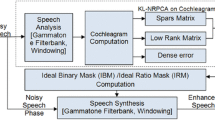Abstract
In this paper, residual noise of corrupted speech observations is further restrained based on eigencomponent (an eigenvalue and its corresponding eigenvector) filtering. Three relevant algorithms are proposed to obtain the core eigencomponents that deeply affect enhancement quality of speech fragments by joint diagonalization of clean speech and noise covariance matrix. In addition, the generalized inverse matrix transform is introduced to the recovery of enhanced speech signal for the issue of matrix irreversibility after eigencomponents are filtered. Experiment results show that the proposed methods work better than many other methods under various conditions on both noise reduction and speech distortion.







Similar content being viewed by others
References
Adukov, V. M. (1998). Generalized inversion of block Toeplitz matrices. Linear Algebra & Its Applications, 274(1–3), 85–124.
Boll, S. F. (1979). Suppression of acoustic noise in speech using spectral subtraction. IEEE Transactions on Acoustics, Speech, and Signal Processing, 27(2), 113–120.
Bouguelia, M. R., Nowaczyk, S., Santosh, K. C., & Verikas, A. (2017). Agreeing to disagree: Active learning with noisy labels without crowdsourcing. International Journal of Machine Learning and Cybernetics. https://doi.org/10.1007/s13042-017-0645-0.
Cohen, I. (2004). Speech enhancement using a noncausal a priori SNR estimator. IEEE Signal Processing Letters, 11(9), 725–728.
Dey and Ashour (2018a). Sources localization and DOAE techniques of moving multiple sources. In Direction of arrival estimation and localization of multi-speech sources (pp. 23–34). Cham: Springer.
Dey and Ashour (2018b). Applied examples and applications of localization and tracking problem of multiple speech sources. In Direction of arrival estimation and localization of multi-speech sources (pp. 35–48). Cham: Springer.
Dey and Ashour (2018c). Challenges and future perspectives in speech-sources direction of arrival estimation and localization. In Direction of arrival estimation and localization of multi-speech sources (pp. 49–52). Cham: Springer.
Ephraim, Y. (1993). A signal subspace approach for speech enhancement. IEEE Transactions on Speech and Audio Processing, 3, 255–258.
Ephraim, Y. (2001). An adaptive KLT approach for speech enhancement. IEEE Transactions on Speech and Audio Processing, 9(2), 87–95.
Ephraim, Y., & Malah, D. (1984). Speech enhancement using a minimum mean square error short-time spectral amplitude estimator. IEEE Transactions on Acoustics, Speech, and Signal Processing, 32(6), 1109–1121.
Hansen, J. H. L., & Pellom, B. L. (1998). An effective quality evaluation protocol for speech enhancement algorithms. In Proceedings of international conference on spoken language processing (Vol. 7, pp. 2819–2822).
Hu, Y., & Loizou, P. C. (2003). A generalized subspace approach for enhancing speech corrupted by colored noise. IEEE Transactions on Speech and Audio Processing, 11(4), 334–341.
Hu, Y., & Loizou, P. C. (2008). Evaluation of objective quality measures for speech enhancement. IEEE Transactions on Audio, Speech, and Language Processing, 16(1), 229–238.
ITU-T Recommendation. (2001). Perceptual evaluation of speech quality (PESQ): An objective method for end-to-end speech quality assessment of narrow-band telephone networks and speech codecs.
Mukherjee, H., Obaidullah, S. M., Santanu, K. C., Phadikar, S., & Roy, K. (2018). Line spectral frequency-based features and extreme learning machine for voice activity detection from audio signal. International Journal of Speech Technology. https://doi.org/10.1007/s10772-018-9525-6.
Phamdo, N. (2000). Signal/noise KLT based approach for enhancing speech degraded by colored noise. IEEE Transactions on Audio, Speech, and Language Processing, 8(2), 159–167.
Saadoune, A., Amrouche, A., Selouani, S. A. (2014). Perceptual subspace speech enhancement using variance of the reconstruction error. Digtal Signal Processing, 24(1), 187–196.
Scalart, P. (1996). Speech enhancement based on a priori signal to noise estimation. In Proceedings of 21st IEEE international conference on acoustics, speech, and signal processing (pp. 629–632). Atlanta, GA.
Sim, B. L., Tong, Y. C., Chang, J. S., & Tan, C. T. (1998). A parametric formulation of the generalized spectral subtraction method. IEEE Transactions on Speech and Audio Processing, 6(4), 328–337.
Sun, C., & Mu, J. (2015). An eigenvalue filtering based subspace approach for speech enhancement. Noise Control Engineering Journal, 63(1), 36–48.
Sun, C., Zhu, Q., & Minghua, W. (2014). A novel speech enhancement method based on constrained low-rank and sparse matrix decomposition. Speech Communication, 60(5), 44–55.
Wiener, N. (1949). Extrapolation, interpolation, and smoothing of stationary time series. New York: Wiley.
Zhibin, C. J. L. (2010). The generalized inverse eigenvalue problem for generalized periodic Jacobi matrices. In International conference on computer design and applications (pp. 354–356).
Author information
Authors and Affiliations
Corresponding author
Rights and permissions
About this article
Cite this article
Huang, K., Liu, Y. & Hong, Y. Reduction of residual noise based on eigencomponent filtering for speech enhancement. Int J Speech Technol 21, 877–886 (2018). https://doi.org/10.1007/s10772-018-09560-y
Received:
Accepted:
Published:
Issue Date:
DOI: https://doi.org/10.1007/s10772-018-09560-y




